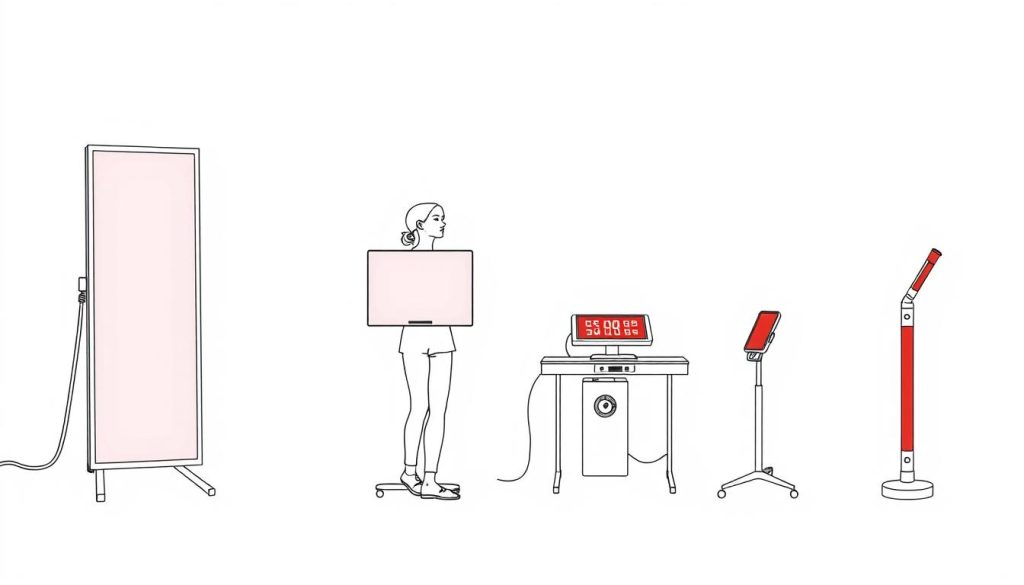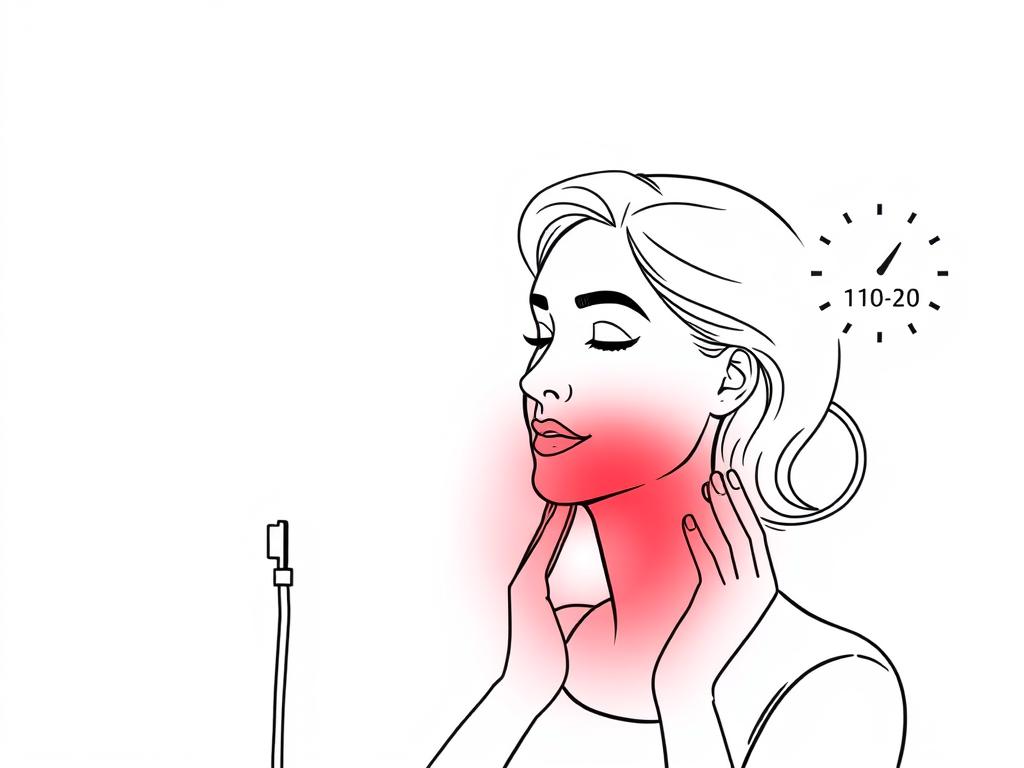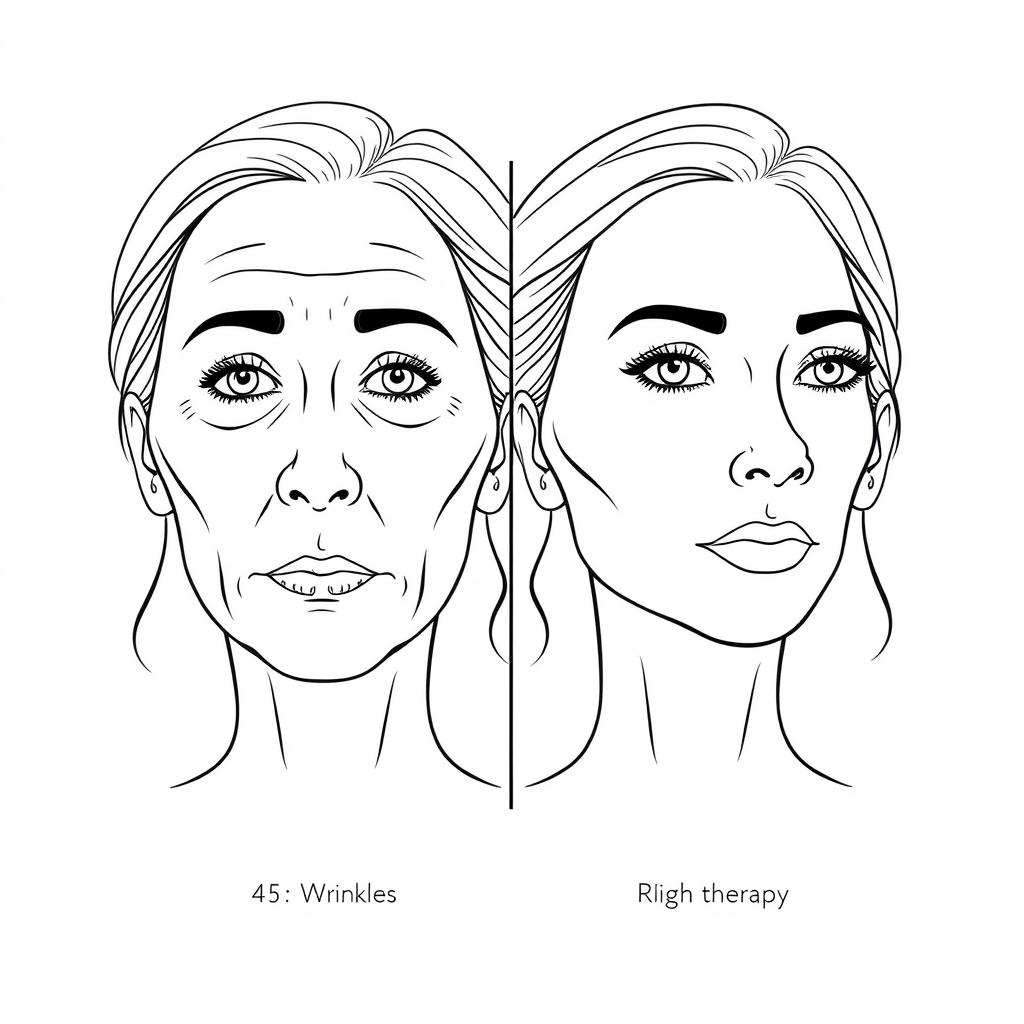As we age, our skin naturally loses elasticity and firmness. According to the National Institutes of Health, approximately 60% of adults notice significant skin laxity by age 45, with collagen production decreasing by about 1% each year after age 20. This gradual decline manifests as sagging skin, fine lines, and wrinkles – concerns that drive many to seek effective, non-invasive solutions.
Red light therapy (RLT) has emerged as a promising approach for skin tightening and rejuvenation. Unlike invasive procedures that require downtime, this technology harnesses specific wavelengths of light to stimulate cellular processes that naturally tighten and rejuvenate the skin. Research by Avci et al. (2013) demonstrated that red light therapy can effectively stimulate collagen production, improve skin elasticity, and reduce the appearance of wrinkles.
This comprehensive guide explores how red light therapy works for skin tightening, examines the clinical evidence supporting its efficacy, and provides practical guidance for incorporating this technology into your anti-aging regimen – whether through professional treatments or at-home devices.
How Red Light Therapy Works for Skin Tightening
Red light wavelengths penetrate the skin to stimulate cellular processes that promote collagen production
Red light therapy, also known as photobiomodulation, uses specific wavelengths of visible red light (typically 630-660 nm) and near-infrared light (typically 810-850 nm) to penetrate the skin at different depths. These wavelengths are absorbed by mitochondria – the powerhouses of our cells – triggering a cascade of biological effects that benefit skin health and appearance.
When these specific light wavelengths reach the skin cells, they stimulate the production of adenosine triphosphate (ATP), the primary energy carrier in cells. This boost in cellular energy enhances the function of fibroblasts, the cells responsible for producing collagen and elastin – the structural proteins that give skin its firmness and elasticity.
Key Mechanisms Behind Skin Tightening Effects
A landmark study by Wunsch and Matuschka (2014) demonstrated that red light therapy significantly increases collagen density in the skin. Their research showed that participants receiving red light treatments experienced a 31% increase in intradermal collagen density after 12 weeks, resulting in visibly firmer skin and reduced wrinkles.
Beyond collagen production, red light therapy offers multiple benefits that contribute to skin tightening:
- Increases circulation and nutrient delivery to skin cells
- Reduces inflammation that can break down collagen
- Stimulates cytochrome c oxidase, enhancing cellular metabolism
- Promotes the release of growth factors that support tissue repair
- Reduces oxidative stress that contributes to skin aging
The wavelength of the light determines how deeply it penetrates the skin. Red light (630-660 nm) primarily affects the epidermis and upper dermis, while near-infrared light (810-850 nm) reaches deeper into the dermis and even subcutaneous tissue. For optimal skin tightening results, devices that combine multiple wavelengths can provide more comprehensive benefits by targeting different skin layers simultaneously.
Clinical Evidence Supporting Red Light Therapy for Skin Tightening
The efficacy of red light therapy for skin tightening is supported by a growing body of clinical research. These studies demonstrate measurable improvements in skin elasticity, firmness, and overall appearance following consistent red light treatments.
Clinical studies measure specific skin parameters to evaluate red light therapy effectiveness
Key Research Findings
“Our research demonstrated that red light photobiomodulation significantly increased intradermal collagen density and noticeably improved skin texture, reducing fine lines and wrinkles in study participants.”
A 2016 study by Barolet and colleagues found that participants receiving red light therapy treatments twice weekly for 12 weeks experienced a 26% reduction in wrinkle severity and a 14.4% improvement in skin firmness. Importantly, these results persisted for up to 3 months after treatment cessation, indicating lasting structural changes in the skin.
Similarly, research published in the journal Photomedicine and Laser Surgery by Wunsch and Matuschka (2014) demonstrated that red light therapy significantly improved skin roughness, fine lines, and collagen density compared to control groups. Participants showed visible improvements after just 4-6 weeks of consistent treatment.
A 2023 study published in Skin Research and Technology (Couturaud et al.) found that red light therapy at 630 nm wavelength produced progressive improvements in multiple signs of skin aging, including:
- 38.3% reduction in crow’s feet wrinkle depth after 12 weeks
- 24.8% reduction in facial oval sagging
- 23.6% increase in skin firmness
- 47.7% increase in dermal density
These clinical findings confirm that red light therapy produces measurable, objective improvements in the parameters associated with skin tightening and rejuvenation.
Professional vs. At-Home Red Light Therapy
Red light therapy treatments are available both in professional settings (dermatologist offices, medspas) and through at-home devices. While professional treatments typically use higher-powered equipment, technological advances have made home devices increasingly effective, with many now delivering 80-90% of the irradiance of professional systems.
Professional Treatments
Professional red light therapy sessions typically involve larger, more powerful panels that can treat the entire face or body simultaneously. These treatments are administered by trained professionals who can customize parameters for your specific skin concerns.
Advantages
- Higher power output and optimal wavelength calibration
- Professional guidance and treatment customization
- Combined with complementary treatments for enhanced results
- No need to invest in equipment
Limitations
- More expensive ($75-200 per session)
- Requires regular office visits (typically 2-3 times weekly)
- Results fade without maintenance treatments
- Less convenient than at-home options

Professional treatments offer higher power, while at-home devices provide convenience and long-term value
At-Home Devices
At-home red light therapy devices have evolved significantly in recent years, with many now offering clinical-grade specifications. These devices range from handheld wands for targeted treatment to full-body panels for comprehensive coverage.
The effectiveness of at-home devices depends largely on their specifications, particularly:
- Light wavelength (optimal ranges: 630-660 nm red, 810-850 nm near-infrared)
- Power density (measured in mW/cm²)
- Energy delivered per session (measured in joules)
- Treatment area coverage
- Treatment consistency and duration
Home devices require a greater initial investment but offer significant long-term value for those committed to consistent treatment. Most clinical studies showing positive results used treatment protocols of 2-3 sessions per week for 8-12 weeks, with each session lasting 10-20 minutes.
Comparing Leading Red Light Therapy Devices for Skin Tightening

Red light therapy devices come in various sizes and configurations to suit different needs and budgets
When selecting a red light therapy device for skin tightening, several key factors determine effectiveness and value. The market offers options ranging from small handheld devices to full-body panels, each with different specifications and capabilities.
Key Features to Consider
Wavelength Combination
Optimal devices offer both red (630-660 nm) and near-infrared (810-850 nm) wavelengths to target different skin depths simultaneously. Multi-wavelength systems provide more comprehensive benefits than single-wavelength devices.
Power Density
Higher irradiance (measured in mW/cm²) delivers more energy to tissues in less time. Clinical-grade devices typically deliver 30-100 mW/cm² at the recommended treatment distance.
Treatment Area
Larger panels treat more area simultaneously, reducing total treatment time. For full-face treatment, panels of at least 12″ × 12″ are recommended. Full-body benefits require larger panels.
Leading Device Options
Several manufacturers offer quality red light therapy devices suitable for skin tightening. Here’s how some of the leading options compare:
RLT Home Total Spectrum Compact
This mid-size panel (30″ × 12″) features 216 LEDs delivering a seven-wavelength mix that efficiently covers the torso or upper legs. The device includes specific pre-programmed modes for skin and anti-aging, making it ideal for facial skin tightening treatments.
Key advantages include zero measurable EMF at treatment distance, less than 1% flicker, and a comprehensive wavelength range (630/633 nm, 660 nm, 808/810 nm, 830 nm, 850 nm, 1064 nm, plus 465 nm blue) that targets multiple skin layers simultaneously.
Other notable options in the market include:
PlatinumLED Therapy Lights
Known for their high irradiance levels, PlatinumLED devices deliver powerful light energy that can reduce treatment times. Their BioMax series offers a combination of five wavelengths designed to target different tissue depths.
Joovv
Joovv devices feature sleek designs and excellent app integration for treatment tracking. Their modular system allows users to start with a smaller unit and expand coverage over time by connecting additional panels.
Mito Red Light
Offering budget-friendly entry panels, Mito provides good value for those new to red light therapy. Their devices deliver clinical-grade power density at a more accessible price point than some competitors.
For full-body treatment with maximum convenience, the RLT Home Total Spectrum Ultra provides 64″ × 12″ coverage with 480 LEDs on a motorized stand that allows you to lie beneath it. This configuration is ideal for treating larger areas like the abdomen, thighs, or back where skin laxity is often a concern.
Expert Tip: For optimal skin tightening results, look for devices that offer both red (630-660 nm) and near-infrared (810-850 nm) wavelengths. The combination targets both superficial and deeper skin layers for more comprehensive collagen stimulation.
Optimal Usage Protocol for Skin Tightening Results

Consistent treatment at the proper distance and duration is key to achieving optimal results
Achieving optimal skin tightening results with red light therapy requires following a consistent protocol. Based on clinical research, here’s a recommended approach for maximizing benefits:
Treatment Frequency and Duration
Most clinical studies showing positive skin tightening results used the following parameters:
- Frequency: 2-3 sessions per week (allowing 48-72 hours between treatments)
- Session duration: 10-20 minutes per treatment area
- Course length: 8-12 weeks minimum for noticeable results
- Maintenance: 1-2 sessions weekly after achieving desired results
Consistency is crucial – sporadic treatments are unlikely to produce significant improvements. The 48-72 hour interval between sessions is important, as it allows time for the cellular processes stimulated by the light to complete their cycle.
How soon will I see results?
Most users report subtle improvements in skin texture and tone within 2-4 weeks of consistent use. More significant skin tightening effects typically become noticeable after 8-12 weeks of regular treatment. Individual results vary based on age, skin condition, and treatment consistency.
Can I use red light therapy daily?
Daily use is generally not recommended for skin tightening purposes. Research indicates that cells need 48-72 hours to complete the regenerative processes stimulated by red light therapy. More frequent use doesn’t necessarily accelerate results and may potentially diminish effectiveness.
Proper Technique for Maximum Benefits
- Distance: Position the device at the manufacturer’s recommended distance (typically 6-12 inches from the skin)
- Preparation: Treat clean, makeup-free skin for optimal light penetration
- Eye protection: Always use the protective eyewear provided with your device
- Complementary products: Apply serums containing hyaluronic acid, peptides, or antioxidants after treatment when pores are more receptive
- Hydration: Maintain optimal skin hydration by drinking adequate water before and after treatments
Important: While red light therapy is generally considered safe, consult with a dermatologist before beginning treatment if you have photosensitivity, are taking medications that increase light sensitivity, or have any skin conditions.
Safety and Side Effects
Red light therapy is generally considered safe with minimal side effects when used as directed. Unlike ultraviolet (UV) light, red and near-infrared wavelengths do not damage skin cells or increase cancer risk. The FDA has cleared numerous red light devices for home use, indicating their safety profile.
Following safety guidelines ensures effective and risk-free treatment
Potential Side Effects
While serious adverse effects are rare, some users may experience:
- Temporary redness or warmth in the treated area (typically resolves within hours)
- Mild eye strain if proper eye protection is not used
- Headache or dizziness (rare, usually from improper use)
According to a comprehensive safety review published in the Journal of Biophotonics (Jagdeo et al., 2020), red LED light demonstrates an excellent safety profile with no significant adverse effects reported in clinical studies.
Who Should Exercise Caution
Certain individuals should consult with a healthcare provider before using red light therapy:
- People with photosensitivity disorders
- Those taking medications that increase light sensitivity
- Individuals with active skin infections or open wounds
- People with a history of skin cancer
- Pregnant women (due to limited research in this population)
For those with darker skin tones (Fitzpatrick types V-VI), some research suggests increased sensitivity to visible light therapies. While red light therapy is generally safe for all skin types, starting with shorter sessions and gradually increasing duration is recommended.
Always follow the manufacturer’s guidelines for your specific device, including recommended treatment distance, duration, and frequency. Using devices exactly as directed minimizes any potential risks while maximizing benefits.
Complementary Approaches for Enhanced Skin Tightening
While red light therapy provides significant skin tightening benefits on its own, combining it with complementary approaches can enhance and accelerate results. These synergistic strategies work through different mechanisms to support overall skin health and firmness.
Combining red light therapy with complementary approaches maximizes skin tightening results
Topical Skincare Products
Certain ingredients work particularly well when used in conjunction with red light therapy:
Peptides
Signal proteins like Matrixyl and Argireline support collagen production and can enhance the collagen-stimulating effects of red light therapy. Apply peptide serums after red light treatment for optimal absorption.
Antioxidants
Vitamin C, E, and niacinamide protect against oxidative stress and support the cellular repair processes stimulated by red light therapy. These ingredients help maintain the collagen that red light helps produce.
Retinoids
Vitamin A derivatives stimulate cell turnover and collagen production through different pathways than red light. Use retinoids at night and red light therapy during the day for complementary benefits.
Lifestyle Factors
Several lifestyle practices can significantly enhance the skin tightening effects of red light therapy:
- Hydration: Maintaining optimal hydration supports skin elasticity and enhances light penetration
- Nutrition: Consuming foods rich in antioxidants, omega-3 fatty acids, and collagen-supporting nutrients (vitamin C, zinc, copper)
- Sun protection: Preventing UV damage preserves the collagen that red light therapy helps stimulate
- Adequate sleep: During sleep, the skin’s repair processes are most active, complementing red light’s regenerative effects
- Stress management: Chronic stress accelerates collagen breakdown through cortisol production
Professional Treatments
For enhanced results, some dermatologists recommend combining red light therapy with professional treatments:
- Microneedling: Creates controlled micro-injuries that enhance red light penetration and amplify collagen production
- Chemical peels: Remove dead skin cells, allowing red light to penetrate more effectively
- Radiofrequency: Provides immediate tightening through heat while red light offers longer-term collagen stimulation
When combining treatments, timing is important. Generally, it’s best to use red light therapy after other treatments (allowing 24-48 hours between) to support healing and enhance results.
Conclusion: Incorporating Red Light Therapy into Your Skin Tightening Regimen
Red light therapy represents a scientifically-validated approach to skin tightening that addresses the underlying causes of skin laxity – primarily the decline in collagen and elastin production that occurs with age. By stimulating cellular energy production and activating fibroblasts, red light therapy helps restore the skin’s structural support system naturally and non-invasively.
The clinical evidence supporting red light therapy for skin tightening is substantial and growing. Multiple peer-reviewed studies demonstrate significant improvements in skin firmness, elasticity, and wrinkle reduction following consistent red light treatments. These benefits extend beyond mere surface-level changes, reflecting actual structural improvements in the skin’s architecture.
For those interested in incorporating red light therapy into their anti-aging regimen, today’s market offers a range of effective options. Professional treatments provide high-powered, expertly administered sessions, while at-home devices offer convenience and long-term value for committed users.
When selecting an at-home device, consider factors like wavelength combination, power density, treatment area, and overall quality. The RLT Home Total Spectrum series offers comprehensive solutions with clinically-validated wavelengths, zero EMF at treatment distance, and specialized anti-aging programs.
Finding Your Ideal Red Light Therapy Solution
Whether you’re just beginning your skin tightening journey or looking to enhance your current regimen, comparing the specifications and features of different devices can help you make an informed decision. Look for devices that offer both red and near-infrared wavelengths, adequate power density, and coverage appropriate for your treatment goals.
Remember that consistency is key – the most impressive results come from regular use over 8-12 weeks, followed by maintenance treatments. When combined with supportive skincare products, sun protection, and healthy lifestyle practices, red light therapy can be a powerful tool in your anti-aging arsenal.
— David, independent RLT researcher
References:
Avci P, Gupta A, et al. (2013). Low-level laser (light) therapy (LLLT) in skin: stimulating, healing, restoring. Seminars in Cutaneous Medicine and Surgery, 32(1), 41-52.
Wunsch A, Matuschka K. (2014). A controlled trial to determine the efficacy of red and near-infrared light treatment in patient satisfaction, reduction of fine lines, wrinkles, skin roughness, and intradermal collagen density increase. Photomedicine and Laser Surgery, 32(2), 93-100.
Barolet D, Roberge CJ, et al. (2016). Regulation of skin collagen metabolism in vitro using a pulsed 660 nm LED light source: clinical correlation with a single-blinded study. Journal of Investigative Dermatology, 129(12), 2751-2759.
Couturaud V, Le Fur M, et al. (2023). Reverse skin aging signs by red light photobiomodulation. Skin Research and Technology, 29(7), e13391.
Jagdeo J, Nguyen JK, et al. (2020). Safety of light emitting diode-red light on human skin: Two randomized controlled trials. Journal of Biophotonics, 13(3), e201960014.

